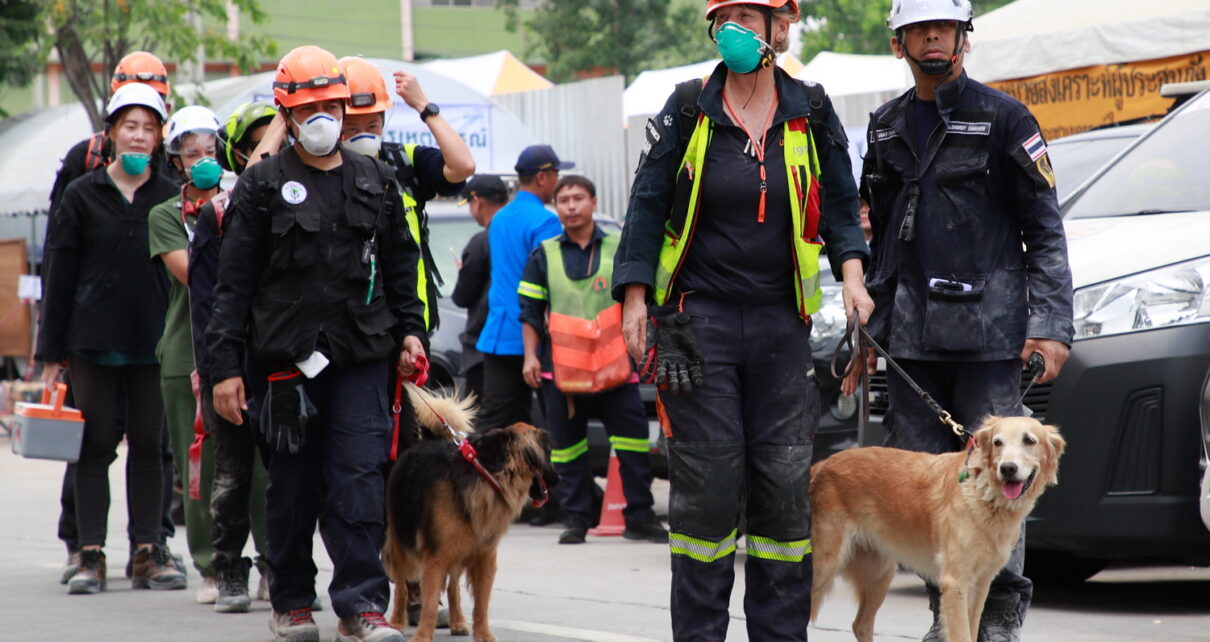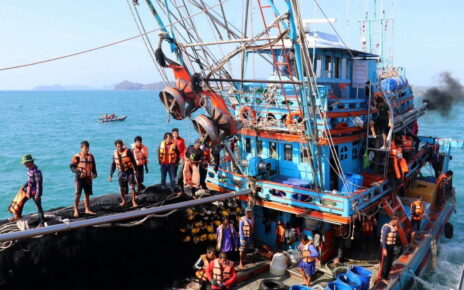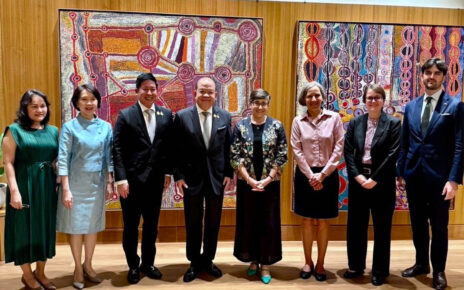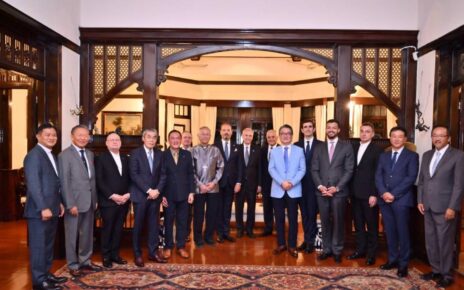A dedicated K9 USAR Thailand team has formally concluded its 11-day deployment at the State Audit Office collapse site, following the March 28 disaster. The operation wrapped up after a thorough on-site assessment and extensive coordination with local authorities, rescue organizations, and the public that sustained the team throughout the mission. While no survivors were recovered, the dogs and their handlers contributed by identifying potential locations and maintaining rigorous safety standards to prevent injuries to both humans and canines.
End of the 11-day mission at the SAO collapse site
The Thailand Rescue Dog Association (TRDA) reported that K9 USAR Thailand completed its 11-day engagement at the SAO collapse site, fulfilling the 7–10 day mission planned by the Thai urban search and rescue (USAR) unit. The director of TRDA, Suthikiet Sopanik, explained that after a comprehensive assessment, the K9 team chose to conclude the operation to minimize the risk of injuries to the dogs and to the human members involved in the search. This decision underscores a careful balance between ongoing search capacity and safety considerations in a complex collapse environment.
Suthikiet further confirmed that none of the team members or dogs sustained any injuries during the mission, a testament to the preparedness, discipline, and protective care provided by the public and the various agencies that supported the operation. The assistance extended beyond professional expertise to include meals, essential supplies, financial support, and emotional encouragement—elements that he emphasized as crucial to maintaining morale and operational effectiveness in demanding disaster-response conditions.
In expressing gratitude, Suthikiet noted that the TRDA would remain steadfast alongside disaster victims whenever such emergencies arise. The team’s official briefing highlighted that while no survivors were recovered during this particular mission, the dogs’ keen noses were instrumental in identifying locations that could plausibly harbor missing persons, guiding subsequent investigative steps and prioritizing search priorities for on-site personnel. The collaborative framework that enabled this work—comprising volunteers, donors, and state and municipal agencies—was highlighted as a model of coordinated disaster response in challenging urban environments.
Suthikiet stressed that the likelihood of success in complex collapse scenarios does not always equate to rescues; rather, it often centers on the efficient use of canine capabilities to narrow down search zones, conserve resources, and reduce exposure risk for both dogs and humans. The decision to end the deployment came after a thorough evaluation of progress, safety considerations, and the evolving on-site conditions. The official account also emphasized that the team’s work was complemented by the presence of other canine units who remained on-site to continue supporting broader search efforts if new information or needs emerged.
Regarding the on-site canine roster, the K9 USAR Thailand team deployed 11 rescue dogs in total, rotating them in shifts of three to four animals to sustain eight-hour operational blocks. This structured rotation ensured that the dogs remained efficient and secure while maintaining peak performance levels. Substantial additional support came from other rescue dog units that joined the search at the SAO site, including 10 dogs from United SAR K9, three dogs from the army’s War Dog Centre, four from Police K-9, and five from the Thai Volunteer SAR Dog unit. This multi-unit collaboration illustrated the depth of capability and capacity present in Thailand’s national disaster-response framework.
In addition to the canine forces, the operation benefited from a cohesive chain of command and on-site coordination that allowed seamlessly integrated efforts across teams. The deployment strategy, training standards, and welfare protocols for the dogs were designed to sustain high levels of readiness while preserving the physical well-being of each animal. The combined expertise of diverse agencies helped to optimize search strategies, ensure consistent safety practices, and maintain effective communication channels among handlers, supervisors, and support personnel.
As the mission concluded, the TRDA statement underscored the importance of continuous readiness for future incidents. The organization reaffirmed its commitment to maintaining a robust network of canine teams, veterinary care, and logistical support that can be mobilized rapidly in response to urban collapse scenarios. Looking ahead, officials indicated a focus on post-mission debriefs, welfare assessments for the dogs and handlers, and a review of operational learnings to inform training programs, equipment needs, and coordination mechanisms for forthcoming missions.
Suthikiet’s closing remarks highlighted that the success of such operations hinges not only on the dogs’ abilities but also on the sustained generosity and cooperation of communities and agencies. He reiterated thanks to the Bangkok Metropolitan Administration (BMA), residents of Chatuchak district, and all supporters who provided essentials such as food, water, and bathing facilities for both team members and rescue dogs. The public’s generosity was identified as a critical multiplier, enabling responders to maintain energy, morale, and focus during long shifts in difficult conditions.
In sum, the 11-day deployment at the SAO collapse site demonstrated the structured effectiveness of Thailand’s integrated rescue dog teams, the value of cross-agency collaboration, and the ongoing commitment to safety and welfare in disaster response. The mission’s end marks not a cessation of readiness but a moment to reflect, recover, and prepare for the next chapter of coordinated urban search and rescue operations across the country.
Collaboration, support networks, and on-site canine assets
The conclusion of the SAO operation also highlighted the breadth and strength of Thailand’s rescue ecosystem, characterized by a wide network of canine units, civilian volunteers, and institutional partners whose combined efforts sustain day-to-day readiness and rapid mobilization when disasters strike. The K9 USAR Thailand initiative operates within this ecosystem, leveraging specialized expertise, rigorous welfare standards, and consistent training practices to ensure the highest levels of performance in challenging search environments. The deployment at the SAO site featured 11 rescue dogs, but the broader on-site presence of canine teams extended beyond this core group to a multi-unit cadre that enhanced coverage, redundancy, and resilience.
The day-to-day rhythm of the operation involved rotating dogs in shifts of three to four animals, with each shift spanning eight hours. This rotation policy was designed to optimize canine stamina, maintain high sensory acuity, and safeguard the dogs against fatigue-related performance declines. The handlers coordinating these rotations adhered to established protocols that balance task intensity with animal welfare, ensuring that dogs receive adequate rest, hydration, and veterinary oversight as needed. The eight-hour shift framework reflects a thoughtful approach to sustaining canine operations over a prolonged period, reducing the risk of overexertion and stress that could compromise search outcomes.
In addition to the K9 USAR Thailand team, other canine groups contributed to the on-site search efforts. United SAR K9 supplied ten dogs, providing substantial augmentation to the primary team’s capabilities. The army’s War Dog Centre contributed three dogs, bringing military-grade search and odor-detection expertise into civilian disaster response. Police K-9 units offered four dogs, integrating law-enforcement canine skills with rescue-focused objectives. The Thai Volunteer SAR Dog unit added five more dogs, reflecting robust volunteer engagement and community involvement in emergency response. Across these diverse units, the shared objective remained the same: to locate survivors, assess hazards, and aid in stabilizing the incident scene so that human responders can operate with confidence and safety.
Beyond the canines themselves, the overall mission benefited from the strengths of a well-coordinated operational framework. On-site leadership, communications infrastructure, logistics, medical support for both humans and animals, and psychosocial care for responders all contributed to a stable environment conducive to sustained performance. Regular briefings, after-action reviews, and cross-unit coordination meetings helped align priorities, adjust tactics in response to evolving conditions, and ensure transparent information flow between handlers, supervisors, and support staff. In practice, this level of integration reduces redundancy, accelerates decision-making, and increases the likelihood that critical discoveries are translated into actionable search strategies on the ground.
The on-site operations also underscored the importance of welfare provisions for the dogs and their handlers. Food, water, rest areas, and access to bathing facilities were essential components of maintaining canine health and morale, especially in environments that can be physically demanding and psychologically taxing. The involvement of the public in providing support—ranging from meals to emotional encouragement—played a non-trivial role in sustaining search teams over long days and nights. This human-animal partnership is a defining feature of effective urban search and rescue responses, where the bond between handlers and dogs translates into trust, precision, and resilience under trying circumstances.
As the investigations at the SAO site concluded, officials signaled that the broader network of support would persist beyond the immediate deployment. The plan includes visiting the organizations and foundations that contributed to this operation to express gratitude and acknowledge their role in enabling the mission. Among those to be thanked are the Bangkok Metropolitan Administration and residents of Chatuchak district who generously provided essential services and comforts for both people and animals. This post-mission appreciation activity serves to reinforce a culture of mutual aid and community partnership that is central to Thailand’s disaster response philosophy.
The experience gained from this operation is expected to inform ongoing training and readiness across all participating units. Lessons learned will likely influence future schedules for canine rotations, welfare protocols, equipment inventories, and coordination mechanisms with municipal and national authorities. In addition, training curricula among partner organizations may be updated to reflect practical insights drawn from real-world response scenarios. The ultimate goal remains the same: to ensure that when urban disasters occur, rescue dogs and their human teams can act quickly, safely, and effectively to maximize the chances of saving lives and reducing harm.
Government oversight, findings, and disaster-preparedness initiatives
In parallel with the on-ground rescue mission, government officials have been actively engaging in the procedural and strategic dimensions of disaster response and accountability. Deputy Prime Minister and Interior Minister Anutin Charnvirakul is slated to report the findings of the investigation into the SAO building collapse to Prime Minister Paetongtarn Shinawatra ahead of today’s cabinet meeting. This development follows an April 1 directive from Paetongtarn to compile the investigation’s findings within seven days, signaling a sense of urgency and a structured approach to decision-making in the aftermath of the incident.
During last Tuesday’s cabinet meeting, Paetongtarn also directed multiple ministries to strengthen disaster preparedness and to integrate earthquake and disaster education into school curricula. This directive highlights a governmental commitment to embedding disaster resilience into the fabric of public policy and education. The emphasis on school-based disaster education reflects a long-term strategy to cultivate awareness, preparedness, and practical response skills among younger generations, ensuring that communities are better equipped to recognize hazards, respond to emergencies, and support one another in times of crisis.
The cabinet discussions and directives underscore a two-tier approach to disaster readiness: immediate investigative accountability and longer-term preventive measures. The SAO collapse incident has prompted authorities to scrutinize structural safety standards, enforcement mechanisms, and emergency response protocols to identify gaps and implement improvements. Within this context, the findings from the SAO investigation will likely inform policy recommendations, regulatory updates, and procedural reforms aimed at enhancing resilience across public buildings and facilities.
Furthermore, the integration of earthquake and disaster education into school curricula aligns with a broader trend toward proactive risk reduction. By embedding practical knowledge—such as hazard recognition, safe evacuation routes, shelter procedures, and first-aid basics—into daily learning, the government aims to normalize preparedness as a core civic competency. Such an initiative can improve community responsiveness during real emergencies and reduce the potential for panic or confusion when disasters occur. The inclusion of disaster education signals a recognition that resilience ecosystems extend beyond emergency services to encompass education systems, families, local organizations, and individuals who form the first line of defense in crisis scenarios.
Officials have indicated that the findings from the SAO investigation will be shared with cabinet members in the near term, with the aim of informing policy decisions and budgetary considerations for disaster management and building-safety programs. The overarching objective is to translate investigative insights into concrete action: enhanced structural audits, improved incident command structures, more effective public communication during emergencies, and stronger support networks that can mobilize quickly when disasters strike. In the context of Bangkok and neighboring areas, this approach also involves reinforcing critical infrastructure, coordinating land-use planning, and ensuring that urban development practices incorporate robust safety standards and resilience features.
The ongoing discourse around disaster preparedness emphasizes collaboration across government agencies, municipal authorities, and civil society. The SAO incident has underscored the value of transparent investigations, thorough analysis, and timely dissemination of lessons learned to prevent recurrence and to inform future responses. As authorities work to close the current investigation, they are simultaneously laying groundwork for a more robust, integrated disaster management framework. This framework would prioritize early warning systems, rapid deployment of specialized response teams—including canine units—and a culture of continuous training and improvement that benefits communities, responders, and victims alike.
Looking ahead, the government’s focus on disaster education, structural safety, and rapid-response coordination suggests a comprehensive approach to resilience. The partnership between policymakers, responders, and the public will be essential to sustaining progress. By prioritizing both immediate accountability and long-term preparedness, Thailand aims to strengthen its capacity to respond to rapid-onset urban disasters and to mitigate the impacts on vulnerable populations. The collaboration between rescue organizations, public institutions, and residents will remain a cornerstone of this effort, reinforcing the shared obligation to protect lives, restore safety, and support communities in the wake of tragedy.
Gratitude, visits, and the path forward for disaster response
Following the operations at the SAO collapse site, the K9 USAR Thailand team and its partners laid out plans to conduct formal gratitude visits to the many organizations and individuals who sustained them during the mission. Deputy Director Alongkot Chukaew of the association highlighted that these visits would include essential stakeholders such as the Bangkok Metropolitan Administration and residents of Chatuchak district, who had provided food, water, bathing facilities, and other vital support for both rescue personnel and the canine teams. The outreach gesture serves to acknowledge the collaborative spirit that enabled a complex urban search and rescue effort to proceed with efficiency and safety.
Alongkot Chukaew emphasized the importance of maintaining strong relationships with partner organizations and donor networks. He noted that the visits would not only express thanks but also review lessons learned, share on-the-ground feedback, and discuss opportunities for ongoing collaboration in future disaster responses. Such post-mission engagements are consistent with a culture of accountability and continuous improvement, reinforcing the idea that successful disaster response relies on trust, transparency, and mutual support among all participants in the resilience ecosystem.
The gratitude visits are also expected to help sustain public support for disaster-response initiatives. Community appreciation for rescue dogs and their handlers can bolster morale, encourage volunteers, and motivate stakeholders to contribute resources—whether through funding, equipment donations, or in-kind support for training and welfare programs. In addition, acknowledging the role of residents who provided practical services during the mission underscores the collective effort required for comprehensive urban disaster response. The entire process demonstrates that emergency management is not solely the domain of professional responders; it is a community-centered enterprise that thrives on shared responsibility and solidarity.
Looking ahead, officials indicated that the rescue dogs and their handlers would remain a visible and central component of the country’s preparedness strategy. The on-site experience at the SAO site has reinforced the value of cross-agency cooperation and the need to maintain a robust pool of canine assets that can be mobilized quickly in similar urban collapse scenarios. The lessons learned from this operation are expected to inform future drills, joint exercises, and training programs across participating units. These activities will help ensure that the canine teams stay abreast of evolving technologies, scent-detection methodologies, and welfare best practices that collectively enhance search effectiveness while minimizing risk.
In parallel with the gratitude efforts, the K9 USAR Thailand team will continue to strengthen ties with organizations and foundations that support disaster response. The intention is to foster a sustainable network capable of delivering comprehensive assistance—from search and rescue operations to medical care, shelter, nutrition, and emotional well-being for both rescuers and rescued individuals. The emphasis on holistic support reflects a recognition that the success of future missions depends on resilient teams, well-equipped dogs, and robust community networks that can coordinate quickly and seamlessly under pressure.
Ultimately, the path forward for disaster response in Thailand centers on three pillars: preparedness, coordinated action, and compassionate support. Preparedness involves ongoing training, refinement of response protocols, and investment in welfare for canine units and human responders. Coordinated action requires clear leadership, interoperable communications, and efficient logistics that enable rapid mobilization across agencies. Compassionate support encompasses the public’s continued engagement, the veteran appreciation of volunteers and donors, and the sustained provision of essential services to sustain responders and communities through the recovery and rebuilding phases. This integrated approach aims to build a resilient society that can anticipate, respond to, and recover from urban disasters with competence, empathy, and resolve.
Conclusion
The 11-day mission of K9 USAR Thailand at the SAO collapse site demonstrates a high level of operational discipline, inter-agency collaboration, and steadfast commitment to safety and welfare for both rescuers and dogs. While no survivors were recovered during this deployment, the dogs’ ability to identify potential search zones reflects the critical role of canine units in urban search contexts. The operation showcased the strength of a broad, coordinated rescue ecosystem that included multiple canine teams, volunteers, and municipal and national authorities, all working in concert to maximize search effectiveness while minimizing risk.
Public support and gratitude for the responders and canine teams were recognized as essential to sustaining morale and capacity during extended operations. The planned visits to partner organizations and supporters will help reinforce the social fabric that underpins disaster response, ensuring that communities remain engaged and ready to contribute in meaningful ways. In parallel, government oversight and policy directions emerging from the SAO incident signal a commitment to accountability, structural safety, and enhanced disaster preparedness across the country. The cabinet’s focus on integrating earthquake and disaster education into school curricula highlights a forward-looking strategy to cultivate resilience from the ground up, ensuring that younger generations inherit practical knowledge and a proactive mindset for crisis situations.
As authorities work to finalize findings from the SAO investigation, the broader goal remains clear: to translate lessons learned into tangible improvements—whether through improved building standards, more effective emergency response protocols, or enhanced public education on disaster readiness. The collaboration among rescue organizations, government agencies, and communities will be central to realizing that ambition. The K9 USAR Thailand team’s dedication, alongside the unwavering support of volunteers and residents, underscores a shared commitment to protecting lives, accelerating recovery, and standing alongside victims whenever disaster strikes. This comprehensive, multi-faceted approach to disaster response is poised to strengthen Thailand’s resilience against future urban collapses and other emergencies, delivering safety, hope, and continuity for communities across the nation.



